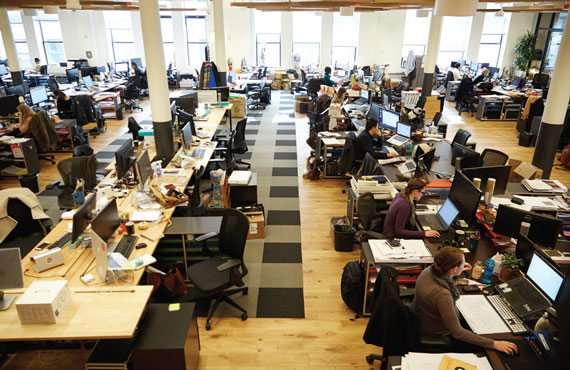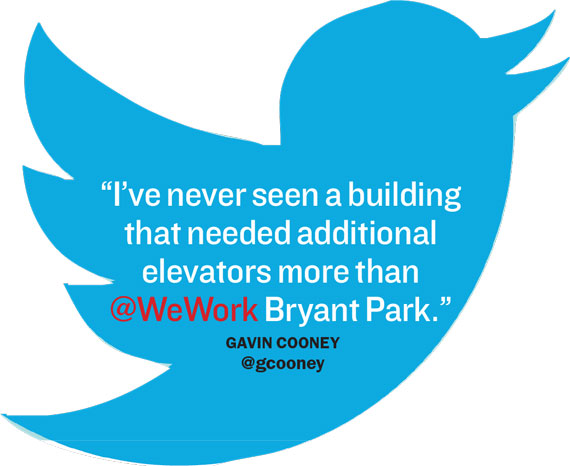Trending
Co-working vs. co-waiting
Densely packed WeWork offices</br> mean elevator lines abound as</br> older buildings feel strain

WeWork offices have been widely praised among the startup and tech crowds. But getting to them is not always easy.
The office-sharing sensation has gobbled up a lot of its square footage in old New York City office buildings that don’t always lend themselves to quick elevator rides and the like.
On social media, WeWork members regularly complain about slow elevators at the co-working company’s locations.
“I’ve never seen a building that needed additional elevators more than @WeWork Bryant Park,” tweeted one WeWork member in October.
Sometimes, the complaints come with snarky humor. “Got a chance to reread ‘Pride and Prejudice’ on the way back up to @WeWork space from lunch. What a masterpiece,” tweeted one user in March.
The problem is not exclusive to office buildings that WeWork leases in. But it is being felt most severely in Midtown South — the destination of choice for tech, media and co-working companies. Like WeWork, these firms tend to pack more people on each floor than traditional companies, creating challenges for the area’s mostly old building infrastructure.
“Overcrowding floors is becoming a big problem,” said Christopher Todd, president of Pride and Service, an elevator maintenance and repair company. “Most buildings were designed a long time ago, and the number of elevators, as well as the size of the elevators designed back then, did not account for what is happening today.”
The problem, however, is not going away anytime soon.
At 120 East 23rd Street, WeWork applied for a permit to increase maximum occupancy per floor to 275 people from 150, according to Department of Buildings records. This would translate to 72 square feet per person in a building built in 1913. By comparison, the national average was 176 square feet at last count in 2012.
Brad Giambrone, an assistant director of operations and maintenance at the Kaufman Organization, which owns and manages several older office buildings, said that while his buildings are well equipped, the influx of high-density tenants could create challenges for other buildings.
 “If you have a 100,000-square-foot building and you only have one entrance with two elevators, you are definitely going to have some backup,” he said.
“If you have a 100,000-square-foot building and you only have one entrance with two elevators, you are definitely going to have some backup,” he said.
Plus, he noted: “When people are waiting for the elevator, [their] patience is pretty short.”
Landlords who lease to WeWork, which declined to comment, say they have not had problems.
David Zar, whose Zar Properties leased out the entire office portion of the eight-story building 349 Fifth Avenue to WeWork four years ago, said he had “no issues whatsoever.”
Meanwhile, Eric Hadar, whose company Allied Partners is WeWork’s landlord at 54 West 40th Street (the aforementioned “@WeWork Bryant Park”), claimed the 12-story building is coping well with its ballooned population.
Allied leased out the entire building to WeWork in 2012. “We weren’t required to do anything significant, didn’t have to add elevators or staircases,” Hadar said, although Allied did add extra bathrooms, sprinklers and electrical capacity.
The experiences some WeWork members describe are less pleasant — especially in taller buildings where WeWork takes up multiple floors.
“A lot of times during peak leaving hours, the elevator will stop on every floor from 26 to 18, and people on 12 or 13, for example, won’t have the space to get on,” a WeWork member at 222 Broadway told TRD in an email under condition of anonymity.
What can be done? According to Todd, very little. He said that landlords sometimes hire his company to do a “traffic analysis.” One solution is to turn freight elevators into regular elevators, but that’s not always possible. “In certain cases, not much can be done besides adding more elevators,” he said. “Most landlords will not do this because it reduces available floor space.”
The good news is that WeWork tenants can stay put, enjoying a beer, a latte, recreational activities and almost anything else needed to last an entire workday. So while the elevator trips may be slow, there’s no need to leave for a Starbucks run.




